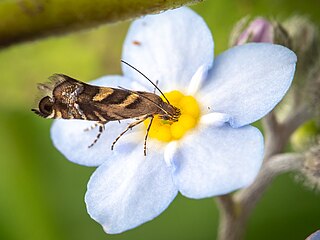
Hypolimnas misippus, the Danaid eggfly, mimic, or diadem, is a widespread species of nymphalid butterfly. It is well known for polymorphism and mimicry. Males are blackish with distinctive white spots that are fringed in blue. Females are in multiple forms that include male-like forms while others closely resemble the toxic butterflies Danaus chrysippus and Danaus plexippus.

Glyphipterix tungella is a species of sedge moth in the genus Glyphipterix. It is endemic to New Zealand and is found throughout the country. Larvae mine the leaves of small sedges. Adults of this species are day flying and inhabit sheltered scrub or grassy areas and forest clearings.
Compsoctena media is a moth in the Eriocottidae family. It was described by Walsingham in 1897. It is found in the Central African Republic.

Dactylethrella bryophilella is a moth in the family Gelechiidae. It was described by Walsingham in 1891. It is found in the Democratic Republic of Congo (Equateur) and Gambia.
Cathegesis angulifera is a moth in the family Gelechiidae. It was described by Thomas de Grey, 6th Baron Walsingham, in 1897. It is found on the West Indies.
Cathegesis psoricopterella is a moth in the family Gelechiidae. It was described by Thomas de Grey, 6th Baron Walsingham, in 1892. It is found on the West Indies.
Dichomeris arotrosema is a moth in the family Gelechiidae. It was described by Walsingham in 1911. It is found in Mexico (Veracruz).
Dichomeris nessica is a moth in the family Gelechiidae. It was described by Walsingham in 1911. It is found in Panama.
Dichomeris latescens is a moth in the family Gelechiidae. It was described by Walsingham in 1911. It is found in Mexico.
Helcystogramma melissia is a moth in the family Gelechiidae. It was described by Walsingham in 1911. It is found in Panama, Puerto Rico and Cuba.
Chionodes occidentella is a moth in the family Gelechiidae. It is found in North America, where it has been recorded from British Columbia to California and Arizona.
Commatica ophitis is a moth in the family Gelechiidae. It was described by Walsingham in 1911. It is found in Mexico (Tabasco), Guyana and Ecuador.
Untomia alticolens is a moth of the family Gelechiidae. It was described by Walsingham in 1911. It is found in Mexico (Guerrero).
Anacampsis conistica is a moth of the family Gelechiidae. It was described by Thomas de Grey, 6th Baron Walsingham, in 1910. It is found in Mexico.
Aristotelia pyrodercia is a moth of the family Gelechiidae. It was described by Walsingham in 1910. It is found in Mexico (Guerrero).
Ptocheuusa scholastica is a moth of the family Gelechiidae. It was described by Thomas de Grey, 6th Baron Walsingham in 1903. It is found in Spain.

Thiotricha tenuis is a moth of the family Gelechiidae. It was described by Walsingham in 1891. It is found on the Seychelles, Mauritius, Réunion, South Africa and Gambia.
Polyhymno subaequalis is a moth of the family Gelechiidae. It was described by Walsingham in 1911. It is found in Mexico (Guerrero).
Hypercallia arista is a moth in the family Depressariidae. It was described by Lord Walsingham in 1912. It is found in Mexico (Veracruz).

Orthenches prasinodes is a moth of the family Plutellidae. It was first described by Edward Meyrick in 1885. This species is endemic to New Zealand and has been observed in both the North and South Islands in the Wellington, Canterbury and Southland regions. It inhabits native forest. The larval host are species in the genus Muehlenbeckia and larvae have been raised on Muehlenbeckia complexia. Adults are on the wing from December until March.




